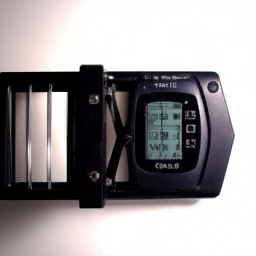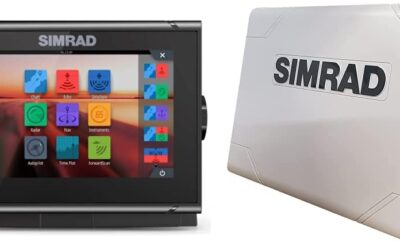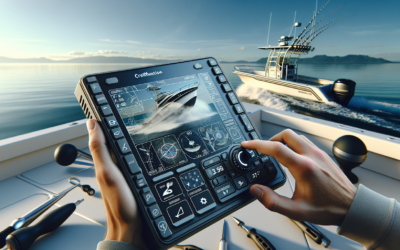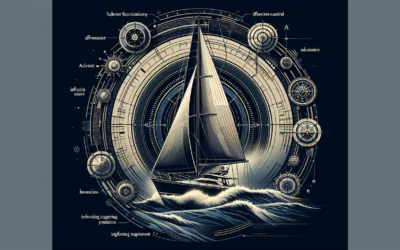In this article, you will discover the fascinating evolution of sonar technology and fish finders, tracing their roots back to World War II and exploring how they have transformed the world of fishing. From their humble beginnings as military tools, sonar and fish finders have revolutionized angling, providing fishermen with an unprecedented advantage in locating and catching fish. Join us as we take a journey through history, uncovering the remarkable advancements that have paved the way for today’s modern angling techniques. Get ready to dive into the exciting world of sonar history and fish finders!
WWII Sonar Technology
Development of sonar during WWII
During World War II, sonar technology saw significant advancements as both the Allied and Axis powers recognized its potential for naval warfare. Sonar, short for sound navigation and ranging, was initially developed by the British in the early 20th century. However, it wasn’t until the war broke out that extensive research and development efforts were undertaken to improve its capabilities. The development of sonar during WWII primarily focused on improving detection ranges, increasing accuracy, and enhancing target identification.
Use of sonar in military operations
Sonar played a crucial role in military operations during WWII, particularly in the naval domain. It allowed vessels to detect enemy submarines and other underwater threats, giving them a significant tactical advantage. By emitting sound waves and analyzing the returning echoes, sonar systems could determine the range, bearing, and depth of underwater targets. This information helped naval forces employ effective countermeasures and avoid potential threats, ultimately safeguarding their ships and crews.
Advancements in sonar technology during the war
The intense wartime demands led to rapid advancements in sonar technology. One major breakthrough was the development of active sonar systems, which emitted sound waves and listened for the echoes. These systems greatly improved target detection capabilities, allowing for precise location and tracking of enemy submarines. Additionally, advancements in signal processing techniques enabled a more accurate interpretation of sonar data, reducing false positives and enhancing the reliability of the technology.
Post-WWII Sonar Applications
Transition of sonar technology to civilian use
Following the end of World War II, there was a significant surplus of military-grade sonar equipment. This surplus, coupled with growing interest in underwater exploration and research, led to the transition of sonar technology from military to civilian applications. Sonar systems that were once used for detecting submarines now found use in a wide range of industries, including oceanography, marine research, and commercial fishing.
Early adaptations of sonar for commercial fishing
One of the earliest applications of sonar in the civilian sector was in the field of commercial fishing. Fishermen quickly realized the potential of sonar in locating fish, enabling them to optimize their catch and operate more efficiently. By using sonar, fishermen could identify schools of fish, determine their depth, and track their movements. This newfound technology revolutionized the fishing industry, increasing productivity and improving resource management.
Challenges and limitations of early sonar fish finders
Early sonar fish finders, although revolutionary, had their share of challenges and limitations. The first-generation fish finders had limited display capabilities, often presenting simple, rudimentary representations of fish and bottom contours. The resolution and accuracy of the images were also relatively low, making it challenging to distinguish between various fish species or identify specific underwater structures. Furthermore, the reliability of early fish finders depended heavily on the skill and interpretation abilities of the user, adding a subjective element to the readings.
Introduction of Fish Finders
Emergence of dedicated fish finding devices
As the demand for fish finders grew, dedicated devices specifically designed for angling and fishing emerged in the market. These devices marked a significant departure from their military-grade counterparts, featuring user-friendly interfaces and tailored functionalities for recreational fishing. The emergence of dedicated fish finders made sonar technology more accessible to anglers of all skill levels, democratizing the use of this powerful tool in the pursuit of fish.
First commercially available fish finders
In the late 1960s and early 1970s, the first commercially available fish finders entered the market. Manufactured by pioneering companies such as Lowrance and Eagle, these fish finders combined sonar technology with user-friendly displays and controls. Anglers could now view real-time sonar readings in a more visually appealing manner, enhancing their understanding of the underwater environment. The availability of affordable and reliable fish finders revolutionized recreational fishing, making it easier for anglers to locate and catch fish.
Initial features and capabilities of early fish finders
The early fish finders offered a range of features and capabilities that greatly benefited anglers. These devices typically included a sonar transducer, which emitted and received acoustic signals underwater, a display unit to visualize the gathered data, and control buttons for adjusting settings. Basic fish finders could provide information on the depth, temperature, and presence of fish. However, the resolution and details were limited compared to modern fish finders, as they relied on basic sonar technology.
Advancements in Fish Finding Technology
Improvements in sonar transducer technology
As fish finders evolved, so did the underlying sonar transducer technology. Transducers responsible for emitting and receiving sound waves underwent significant improvements in terms of accuracy, sensitivity, and signal processing capabilities. This led to higher-resolution images and better target separation, allowing anglers to differentiate between individual fish and underwater structures. Beam angles of sonar transducers increased, providing wider coverage and a more comprehensive view of the underwater landscape.
Integration of GPS and mapping functionalities
To further enhance the capabilities of fish finders, manufacturers started integrating GPS (Global Positioning System) technology into their devices. This enabled anglers to mark waypoints, create maps of their fishing spots, and navigate with precision. By combining sonar data with GPS coordinates, fishermen could easily return to productive areas and track their movements on the water. This integration of GPS greatly improved the overall fishing experience, ensuring that anglers could target specific locations and increase their chances of success.
Development of multi-frequency and CHIRP sonar
Another significant advancement in fish finding technology was the introduction of multi-frequency and CHIRP (Compressed High-Intensity Radar Pulse) sonar systems. These systems allowed for a more detailed and accurate representation of the underwater environment. By utilizing multiple frequencies or a continuous range of frequencies, fish finders could provide clearer images with improved target separation. CHIRP sonar, in particular, offered superior resolution and enhanced sensitivity, making it easier to identify individual fish species and differentiate between fish and other objects.

Sonar and Fish Finder Components
Explanation of sonar transducers and their types
Sonar transducers are the key components of fish finders that emit and receive sound waves in the water. They work on the principle of piezoelectricity, where electrical energy is converted into mechanical vibrations and vice versa. Sonar transducers come in various types, including single-frequency, dual-frequency, and CHIRP transducers. Single-frequency transducers emit sound waves at a specific frequency, while dual-frequency transducers can emit at two different frequencies simultaneously. CHIRP transducers, on the other hand, emit a range of frequencies, providing superior image detail and target separation.
Overview of display units and their features
The display unit of a fish finder is responsible for presenting sonar readings in a user-friendly manner. Early display units used cathode ray tubes (CRTs) to visualize the data, but modern fish finders employ LCD or LED screens. LCD displays offer better visibility in bright sunlight and consume less power, making them ideal for portable fish finders. Many display units now feature color screens, allowing for more detailed and vivid representations of the underwater landscape. Some advanced displays also offer split-screen functionality, enabling users to view multiple sonar readings simultaneously.
Importance of power supplies and batteries
As with any electronic device, fish finders require a steady power supply to function properly. Most fish finders come with an internal battery, but external power sources can also be used, such as a boat’s electrical system. The importance of a reliable power supply cannot be overstated, as it ensures uninterrupted operation and prevents unexpected equipment failures. Anglers should always consider the battery life and charging capabilities of their fish finders, especially during longer expeditions or remote fishing trips.
Understanding Sonar Technology
Principles behind sonar operation
Sonar technology relies on the principles of sound wave propagation and echo detection. When a sonar system emits a sound wave into the water, it travels through the medium until it encounters an object. The sound wave then reflects off the object and returns to the sonar system as an echo. By measuring the time it takes for the echo to return and analyzing its characteristics, the sonar system can determine the distance, direction, and composition of the object. This fundamental operation forms the basis of underwater detection and mapping capabilities provided by fish finders.
Different types of sonar signals
Sonar signals can be broadly classified into two types: active and passive sonar. Active sonar involves emitting sound waves from the sonar system and analyzing the returning echoes. This method enables precise target detection and identification. Passive sonar, on the other hand, involves listening for naturally occurring sounds in the water, such as those produced by fish or other marine life. Passive sonar is often used in research and monitoring applications, as it provides valuable insights into the underwater ecosystem without disturbing the environment.
Sonar beam angles and cone coverage
Sonar systems emit sound waves in a specific pattern called a beam. The angle at which these sound waves spread determines the beam angle and the coverage area. Wider beam angles, such as 60 degrees, provide a broader view of the underwater landscape but with reduced detail. Narrower beam angles, such as 20 degrees, offer a narrower, more focused view with higher resolution. Some advanced fish finders feature adjustable beam angles, allowing anglers to customize the coverage area based on their specific fishing requirements.
Interpreting Sonar Readings
Identification of fish arches and echoes
One of the primary goals of using a fish finder is to locate fish. Sonar readings often show fish as distinct arch-shaped echoes. These fish arches indicate the presence of fish in the water column and are formed when the sound waves bounce off their bodies. The size and thickness of the arches can provide insights into the size and species of the fish. However, it’s important to note that fish arches may not always be clear and may vary depending on various factors, such as water depth, speed of the boat, and fish behavior.
Analysis of bottom contours and structures
Fish finders are not solely for locating fish; they also provide valuable information about the underwater terrain and structures. By analyzing sonar readings, anglers can identify the contours of the bottom, including variations in depth and composition. This knowledge is crucial for determining the ideal fishing spots and understanding the behavior of fish. Furthermore, fish finders can detect underwater structures such as submerged vegetation, reefs, or sunken objects. Recognizing these features helps anglers target specific areas likely to hold fish.
Understanding of water column and depth readings
Fish finders provide readings of the water column, indicating the depths at various locations. This information is vital for angling success, as different fish species exhibit preferences for specific depth ranges. By observing the water column readings, anglers can identify thermoclines, where temperature changes occur, potentially concentrating fish at specific depths. Additionally, water column readings help determine the appropriate depth at which to present bait or lures, maximizing the chances of enticing a strike.
Benefits and Drawbacks of Fish Finders
Increased efficiency and success in angling
One of the key benefits of fish finders is their ability to significantly enhance angling efficiency and success rates. By providing real-time sonar readings, fish finders help anglers locate fish, identify optimal fishing spots, and make informed decisions on bait and lure presentation. This increased efficiency not only saves time but also maximizes the chances of encountering fish, leading to a more rewarding angling experience.
Enhanced safety and navigational aid
Fish finders, especially those integrated with GPS technology, offer enhanced safety and navigational capabilities. GPS-enabled fish finders allow anglers to mark navigational waypoints and create maps of their fishing spots. This feature helps prevent getting lost at sea and provides a reliable means of returning to productive fishing areas or safe harbor. Furthermore, fish finders can indicate water depths, enabling anglers to avoid shallow areas and potential hazards.
Limitations and potential drawbacks
While fish finders offer numerous benefits, it’s important to acknowledge their limitations and potential drawbacks. Fish finders heavily rely on water conditions and the behavior of fish. Factors such as water clarity, presence of debris or vegetation, and fish movements all influence the accuracy and effectiveness of sonar readings. Additionally, fish finders require a learning curve to interpret the data correctly, and their reliance on technology means they may encounter malfunctions or false readings. It’s essential for anglers to understand the limitations of fish finders and supplement their use with other fishing techniques and knowledge.
Modern Applications of Fish Finders
Use in recreational and professional fishing
Modern fish finders have become indispensable tools for both recreational and professional anglers alike. Whether fishing from a small kayak or a large commercial vessel, fish finders provide valuable insights into the underwater environment, helping anglers locate and catch fish with greater precision. The use of fish finders has revolutionized angling, making it more accessible and increasing the chances of a successful fishing trip.
Integration with mobile devices and apps
With the advent of mobile technology, fish finders have taken advantage of the connectivity and processing power of smartphones and tablets. Many fish finders now offer wireless connectivity options, allowing them to pair with mobile devices through dedicated apps. This integration enables anglers to access advanced features, such as detailed mapping, social sharing, and real-time weather updates, all from the convenience of their mobile devices.
Emerging technologies in fish finding
The continuous development of fish finding technology promises exciting advancements in the near future. One emerging trend is the integration of artificial intelligence (AI) algorithms into fish finders. AI-powered fish finders can learn from vast amounts of data and provide anglers with intelligent recommendations on fishing techniques, tackle selection, and even projected fish movements. Additionally, the miniaturization and portability of fish finders are expected to improve further, making them more accessible to kayak anglers and shore fishermen.
Future Trends in Sonar Technology
Advancements in imaging and target identification
Future advancements in sonar technology are expected to focus on improving imaging capabilities and target identification. Higher-resolution imaging systems will provide anglers with even more detailed representations of the underwater environment, enabling precise identification of fish species, individual fish behavior, and underwater structures. This enhanced imagery will take fish finding to a whole new level, revolutionizing the way anglers interact with their underwater surroundings.
Integration with artificial intelligence
As AI technology continues to advance, fish finders are likely to incorporate more sophisticated AI algorithms. These algorithms would leverage data from various sources, such as historical fishing data, environmental conditions, and fish behavior patterns, to provide anglers with real-time recommendations and predictive analysis. AI-powered fish finders could assist in selecting the most effective fishing techniques, optimizing bait or lure choices, and even adjusting settings based on prevailing fishing conditions.
Continued miniaturization and portability
Fish finders have already experienced substantial miniaturization and increased portability over the years. This trend is expected to continue, with fish finders becoming even more compact, lightweight, and portable. Compact fish finders are particularly advantageous for kayak anglers or those fishing from small boats, where space is limited. Furthermore, the decreased size and weight of fish finders will provide greater convenience for anglers who prefer a mobile and flexible fishing setup.
In conclusion, the development and evolution of sonar technology, from its military applications in WWII to modern fish finders, have transformed the world of angling. Fish finders have revolutionized recreational and commercial fishing, allowing anglers to locate and catch fish with greater efficiency and precision. As advancements in sonar technology continue, we can expect even more exciting features and capabilities that will further enhance the angling experience. From AI integration to improved imaging and portability, the future of fish finders looks bright, promising endless possibilities for modern anglers. So, whether you’re a weekend fishing enthusiast or a seasoned professional, don’t forget to equip yourself with a trusty fish finder on your next fishing adventure – you’ll be amazed at the difference it can make!












